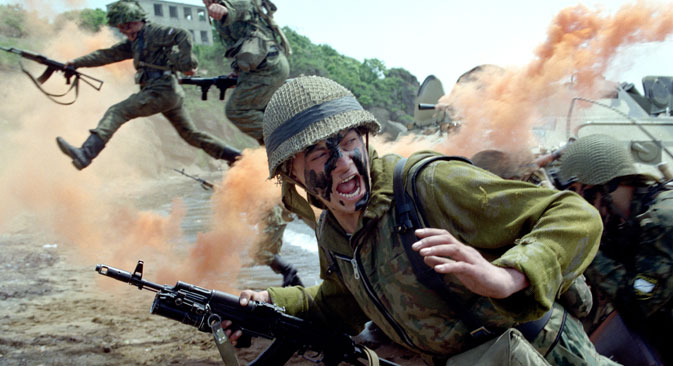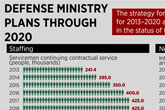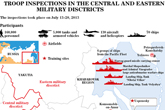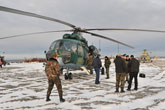Geopolitics of military reform: Results of 2013

The current year has shown more than any other year what the transformation in the Army is aimed at achieving. Source: Vitaly Anikov / RIA Novosti
Comprehensive testing of the combat readiness of the Armed Forces; a large-scale rearmament of the Army and Navy; a new military bases in the Arctic; and an emphasis on nuclear deterrence for a potential enemy – these are the main results of the activities of the Ministry of Defense of Russia in 2013.
Company, rise!
Sergey Shoygu took up the post of Minister of Defense of Russia in a very difficult situation. His predecessor, Anatoliy Serdyukov, literally broke an established Soviet model of the Armed Forces, tested by time and wars. At the same time, it was Shoygu who had to bear responsibility for the efficiency of these decisions.
That is why President Vladimir Putin decided to conduct unexpected tests of the combat readiness of the Army and Navy for the first time in 20 years. They were unexpected in the literal sense of the word, as the Minister of Defense was ordered to place “on combat alert” the Central Military District in mid-February, when he was in an airplane on his way to a foreign destination.
After the Central Military District, similar events were held in the Western and Southern Military Districts. In July, combat readiness was suddenly tested in the Eastern Military District, and in October, they assessed the readiness to repel a possible nuclear attack by nuclear deterrence forces of the Aerospace Defense, the Navy and Long-range Aviation. Characteristically, each test was accompanied by large-scale redeployments of troops and equipment from one end of the country to another.
According to the military, such tests provided an opportunity not only to objectively assess the level of readiness of the Army and Navy, to practice cooperation between all of their elements, but also to reveal existing problems of Army reform. President Putin was satisfied with the test results. However, in December he set a number of priorities for Shoygu at the Collegium of the Ministry of Defense, the main one being an accelerated rearmament of the Army with new weapons and military equipment.
Buy domestic products
During the reform of the Army, conducted by Serdyukov, there was a paradoxical situation. Russia, a world leader in sales of arms and military equipment on the world market, preferred Western equipment for its own army. Shoygu radically changed this situation in less than a year.
During this time, the Army was given two missile regiments with new Yars strategic missile systems. Two missile brigades of the Ground Forces were rearmed with Iskander missile complexes. Two air bases received the latest Su-34 frontline bombers, Yak-130 trainer aircraft, and Mi-28N and Mi-35 M helicopters. The Navy received two new strategic missile cruisers – 955 design of the Borey type.
Six mechanized infantry brigades and one tank brigade were rearmed with modern T-90 tanks and Msta-S artillery systems. Thirty-six military units received modern means of communications and six mechanized infantry brigades received new electronic warfare equipment. Thanks to this, the ministry managed to increase the share of modern weapon systems and military equipment to 17 percent in 2013. In total, there will be 30% of these by the end of 2015, and 70 to 100 percent by 2020.
Cold calculations of Moscow
The current year has shown more than any other year what the transformation in the Army is aimed at achieving. Moscow has openly acknowledged that it has deployed a brigade with Iskander tactical missile complexes in Kaliningrad Oblast. These missiles can hit any well-defended targets at ranges up to 500 kilometer from the Russian border: airfields, ammunition depots, personnel and equipment of the enemy, as well as positions with U.S. missile defense systems.
In addition, Russia has almost completely restored the country’s missile early-warning system this year. It has placed into operation 4 of the 8 Voronezh-DM radar stations currently under construction, which can keep track of everything that is going on in the airspace around Russia at a distance of 6,000 km.
An operational command was established in the Mediterranean in June of this year for the protection of Russia’s national interests. Now Russian Navy formations are constantly present in this area. Combat capacity of the airborne troops has been strengthened by the inclusion of three air assault brigades of the Ground Forces, which will allow Moscow to respond more effectively to the emergence of any security threats along its borders.
However, perhaps the strongest move made was the creation of a network of military bases in the Arctic Region. These will be completely ready next year. Plans call for deploying units of Aerospace Defense on Novaya Zemlya, creating rapid response brigades, and Navy ships will be on permanent combat alert duty throughout the Northern Sea Route. Thus, Moscow is going to support its claims for an expansion of the continental shelf, securing the rights to new oil and gas deposits on the bottom of the Arctic Ocean, as well as the new transport corridor between the Pacific and Atlantic Oceans.
All rights reserved by Rossiyskaya Gazeta.
Subscribe
to our newsletter!
Get the week's best stories straight to your inbox


